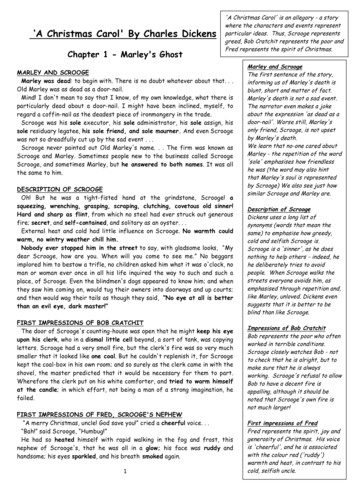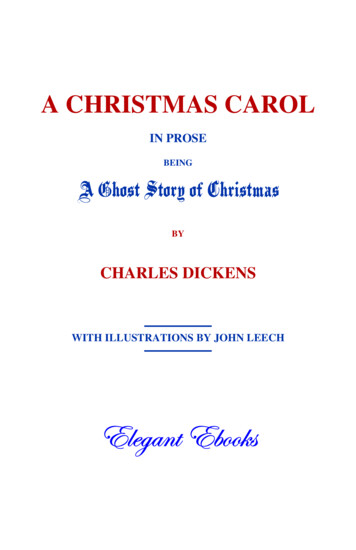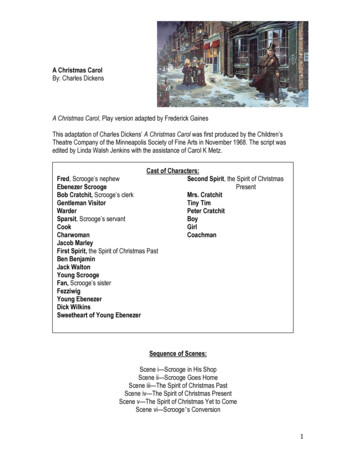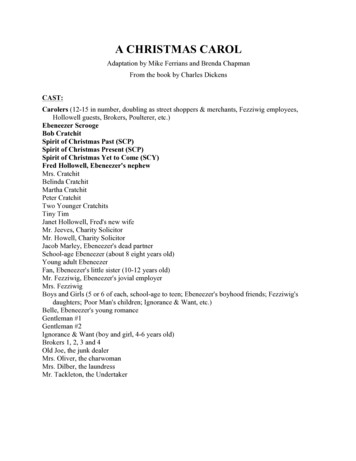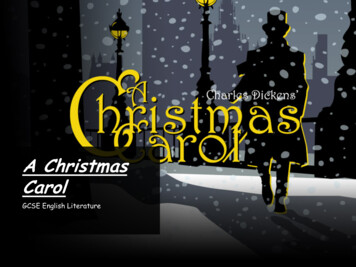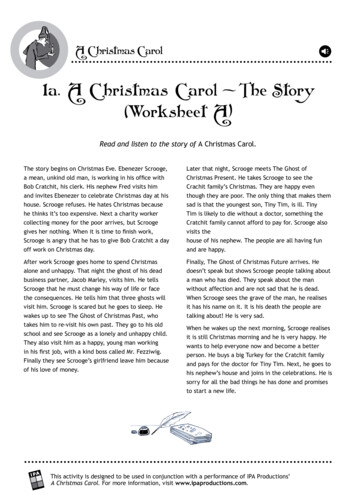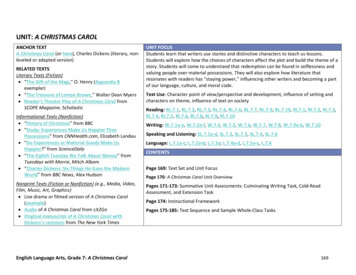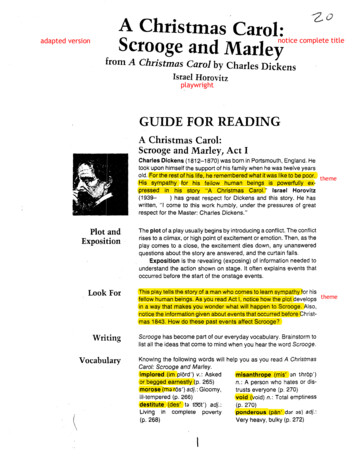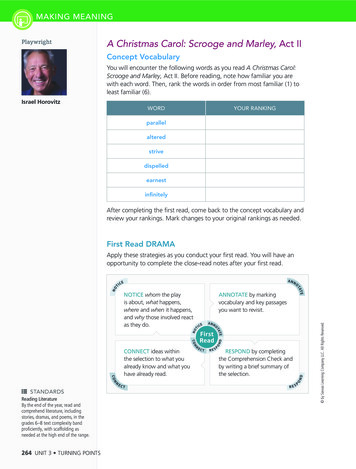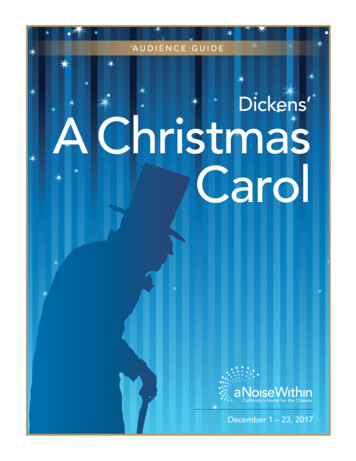
Transcription
AUDIENCE GUIDEDickens’A ChristmasCarolCalifornia’s Home for the ClassicsDecember 1 – 23, 2017California’s Home for the Classics
TABLE OF CONTENTSA Christmas Carol: Characters. . . . . . . . . . . . . . . . . . . . . . . . . . . 4About the Play: Synopsis . . . . . . . . . . . . . . . . . . . . . . . . . . . . . . . 5Quotes from A Christmas Carol. . . . . . . . . . . . . . . . . . . . . . . . . . 6Charles Dickens: Biography . . . . . . . . . . . . . . . . . . . . . . . . . . . . . 7Dickensian Timeline:Important events in Dickens’ Life and Around the World. . . . . . 9Dickens’ Times: Victorian London . . . . . . . . . . . . . . . . . . . . . . . 10Poverty: Life or Death . . . . . . . . . . . . . . . . . . . . . . . . . . . . . . . . 13Currency & Wealth. . . . . . . . . . . . . . . . . . . . . . . . . . . . . . . . . . . 16About: Scenic Design. . . . . . . . . . . . . . . . . . . . . . . . . . . . . . . . . 18About: Costume Design. . . . . . . . . . . . . . . . . . . . . . . . . . . . . . . 19A Christmas Carol: Overall Design Concept. . . . . . . . . . . . . . . 20Production Music: Ego Plum . . . . . . . . . . . . . . . . . . . . . . . . . . . 21Resource Guide. . . . . . . . . . . . . . . . . . . . . . . . . . . . . . . . . . . . . . 23About A Noise Within. . . . . . . . . . . . . . . . . . . . . . . . . . . . . . . . 24
3 A NOISE WITHIN 2017/18 REPERTORY SEASON Holiday 2017 Audience GuideA Christmas CarolCHARACTER MAPCHRISTMAS PASTCHRISTMAS PRESENTCHRISTMAS YETTO COMEEBENEZER SCROOGEThe protagonist; a bitter old creditorwho does not believe in the spirit of Christmas,nor does he possess any sympathy for the poor.JACOB MARLEY“Dead to begin with.”Ebenezer Scrooge’s formerbusiness partner, who died sevenyears prior. His ghost appearsbefore Scrooge on Christmas Eveto warn of him of the ThreeSpirits, and urges him to choose anew path in life.GHOST OF CHRISTMASPASTInvokes images from Scrooge’spast to serve as a reminderthat Christmas once meantsomething to him.MR. & MRS. FEZZIWIGMr. Fezziwig was Scrooge andMarley’s former boss at thewarehouse. A generous man,who held Christmas partiesfor his staff every year.BELLEScrooge’s former fiancée;he chose greed over love.FANScrooge’s older sisterand Fred’s mother.GHOST OF CHRISTMASPRESENTGHOST OF CHRISTMASYET TO COMEFREDOLD JOE, MRS. DILBER,LAUNDRESS, ANDUNDERTAKER’S MANA lively spirit who spreadsChristmas cheer.Scrooge’s optimistic, kind-heartednephew; he overlooksScrooge’s negativity.Scrooge fears this ghost’spremonitions.In the future, they meet to sharein the profits of selling-offScrooge’s belongings.BOB CRATCHITScrooge’s overworked andunderpaid clerk. Although he andhis family struggle for money, theycarry on and look towards thefuture.MRS. CRATCHITOTHERS:NARRATORKindly provides story informationto you, our spectators.Bob’s wife.TINY TIMBob’s youngest son; crippled atbirth and equipped with a lovingspirit.PETER, MARTHA,BELINDA,& THE LITTLE CRATCHITSOther Cratchit children.GENTLEPEOPLE,CAROLERS, PARTYGUESTS, SERVANTS, ETC.
4 A NOISE WITHIN 2017/18 REPERTORY SEASON Holiday 2017 Audience GuideA Christmas CarolSYNOPSISBy Charles DickensAdapted for the stage by Geoff ElliottON A FRIGID Christmas Eve, amiserly old man named EbenezerScrooge sits in his counting house,keeping an eye on his clerk, BobCratchit. The stingy Scrooge refusesto spend money on heating coals,so poor Cratchit shivers in the dimroom. Scrooge’s nephew, Fred,drops by and wishes him a MerryChristmas, though Scrooge replieswith a bitter “Bah! Humbug!” Later,two gentlemen enter his officeand ask him to donate money fora fund that will feed the hungry.Scrooge feels no pity for the plightof those less fortunate and promptlydismisses the gentlemen. At closingtime, Scrooge reluctantly givesCratchit the day off for Christmas.Scrooge returns home, where helives in a house that belonged to hisdeceased business partner, JacobMarley. Late at night, the sound ofdragging, metal chains announcesthe arrival of The Ghost of JacobMarley. Marley has a grave messagefor Scrooge. Because Marley liveda greedy and selfish life, his ghostnow wanders the Earth in heavychains as punishment. He hopes hecan help Scrooge avoid the samefate. He tells Scrooge that threespirits will visit him, with the firstarriving when the bell tolls one.As promised, the Ghost ofChristmas Past arrives, leadingScrooge on a journey to theChristmases of his childhood.He sees himself as a lonely child,an apprentice to Fezziwig themerchant, and as a young man wholoses his sweetheart Belle’s love tohis greed. Tortured, Scrooge begsthe ghost to take him home.The Ghost of Christmas Presenttakes Scrooge through Londonto unveil the Christmas holiday asit will unfold that year. Scroogewatches the large and bustlingCratchit family prepare a miniaturefeast in their meager home. Hediscovers Bob Cratchit’s crippledson, Tiny Tim, a courageous boywhose kindness and humility warmsScrooge’s heart. The specter thenwhisks Scrooge to his nephew Fred’shouse to witness their Christmasparty. Scrooge finds the jovialgathering delightful and pleadswith the spirit to stay until the veryend of the festivities. As the dayprogresses, the spirit ages, and wesee a noticeably older ghost. Priorto his departure, the ghost revealsto Scrooge two starved children,Ignorance and Want, living underhis coat. He vanishes instantly asScrooge notices a dark and hoodedfigure approaching.The Ghost of Christmas Yet ToCome, the spirit Scrooge fearsmost of all, leads Scrooge througha sequence of mysterious scenesrelating to an unnamed man’s recentdeath. Scrooge sees businessmendiscussing the dead man’s richesand some thieves pawning hispersonal effects for cash. Scrooge,anxious to learn the lesson of hislatest visitor, begs to know thename of the dead man. Afterpleading with the ghost, Scroogefinds himself in a churchyard, thespirit pointing to a grave. Scroogelooks at the headstone and isshocked to read his own name. Hedesperately implores the spirit toalter his fate, promising to renouncehis insensitive, avaricious ways andto honor the Christmas spirit. Hesuddenly finds himself safely tuckedin his bed.Overwhelmed with joy at thechance to redeem himself, andgrateful that he has been returnedto Christmas Day, Scrooge rushesout onto the street hoping to sharehis newfound Christmas spirit. Hesends a giant Christmas turkey tothe Cratchit house and attendsFred’s party, to the stifled surpriseof the other guests. As the years goby, he holds true to his promise andhonors Christmas with all his heart:he treats Tiny Tim as if he werehis own child, provides gifts to thepoor, and treats his fellow humanbeings with kindness, generosity,and warmth.
5 A NOISE WITHIN 2017/18 REPERTORY SEASON Holiday 2017 Audience GuideA Christmas Carol
6 A NOISE WITHIN 2017/18 REPERTORY SEASON Holiday 2017 Audience GuideA Christmas CarolABOUT THE AUTHOR: CHARLES DICKENSCHARLES DICKENS, English writer of novels andshort stories, was the second of eight children born toJohn and Elizabeth Dickens in Portsmouth, England onFebruary 7, 1812. He is one of the most famous Englishnovelists of the Victorian Era. As a young child, Dickensspent most of his time reading; he was also quite fond oftheatricals, puppet plays, and had a natural singing voice.Due to Dickens’ father’s job, the family relocatedseveral times until they settled in Camden Town, a poorneighborhood in London, where Bob Cratchit and hisfamily dwell in A Christmas Carol. At the age of 12,Dickens’ father was sentenced to debtor’s prison, soyoung Charles left school and went to live with a familyfriend and work in a shoe-blacking factory. Dickens’family, excluding his sister Fanny, all lived at the prison.Each Sunday, Charles visited the prison and witnessedthe disgusting conditions in which London’s working poorwere forced to live.After several months, an unexpected inheritance relievedDickens’ father from his debt, and Charles eventuallyleft the factory and returned to school. Still, Charles’ jobgluing labels on bottles traumatized him, leaving a deepimpression that would haunt him for the rest of his life.These difficult times inspired Charles Dickens to includemany economic and child labor issues in his fiction.Dickens in New York, 1867, Wikipedia.At age 15, Dickens’ father met with new financialdifficulties, which caused Charles to leave school andseek permanent employment. Although his formaleducation was limited, his enthusiasm for reading and hisnatural writing ability carried him far. He first worked asa clerk in a legal office, and later as a stenographer in thelaw courts of London.By 1832 he became a reporter for two Londonnewspapers. In the following year, he began tocontribute a series of impressions and sketches to variouspublications under the pen name “Boz.” The same year,Dickens began to write The Pickwick Papers in severalmonthly installments. This form of serial writing becamea standard method of writing fiction in the Victorian Era.In fact, many of Dickens’ successful novels, such as OliverTwist, Nicholas Nickelby, Great Expectations, and A Taleof Two Cities began as magazine installments.In 1836, Dickens married Catherine Hogarth, thedaughter of the editor of a London newspaper. Togetherthey had ten children.
7 A NOISE WITHIN 2017/18 REPERTORY SEASON Holiday 2017 Audience GuideIn 1842, Dickens went on a five-month long lecture tourof America, speaking out strongly for the abolition ofslavery and of other reforms, during which he wrote histravelogue, American Notes for General Circulation.Soon after his return to England, Dickens began towrite A Christmas Carol (1843), the first of three storiesDickens penned about Christmas (followed by TheChimes (1844) and The Cricket on the Hearth (1845). AChristmas Carol was immediately popular, but Dickensreceived few of the initial profits due to poor contractagreements. The next year, Dickens performed alive reading of The Chimes, which launched Dickens’extensive career in delivering oral interpretations.Dickens continued performing this way for charity and forpleasure for the remainder of his life, and even formedan amateur theatre company in 1848, where he served asmanager, producer, and actor.In the early 1850s, Dickens was confronted with thedeath of his father and one of his daughters within twoweeks. Partly in response to these losses, Dickens beganwriting what are now known as his “dark” novels whichinclude Bleak House, Hard Times, and Little Dorrit.In 1857, Dickens fell in love with an actress named EllenTernan, and separated from his wife, Catherine, aftermany years of incompatibility.From December 1860 to August 1861, Dickens serializedthe largely autobiographical Great Expectations. Thestory was published in All the Year Round, a periodicalowned and created by Dickens.In the 1860s, Dickens devoted much of his time andenergy to public readings from his novels. Traveling grewtiresome, and a train wreck in 1865 left Dickens withA Christmas CarolA Chronology of Dickens’ Major Works1836: Pickwick Papers1848: The Haunted Man1837: Oliver Twist1849: David Copperfield1838: Nicholas Nickleby1853: Bleak House1840: The Old Cottage1854: Hard Times1841: Barnaby Rudge1855: Little Dorrit1843: A Christmas Carol1856: Our Mutual Friends1844: The Chimes1859: A Tale of Two Cities1845: The Cricket on the1860: Great ExpectationsHearth1846: The Battle of Life1870: The Mystery ofEdwin Drood1847: Dombey & Sondizzy spells, arthritis, gout, and swelling in his left foot.Still, he carried on and performed throughout the UnitedStates and Britain.On June 8, 1870, Dickens spent all day working on TheMystery of Edwin Drood, which was rare for the manwho normally only wrote for a couple of hours each day.That night, Dickens complained of a toothache, and lostconsciousness.Charles Dickens died from complications of a stroke onJune 9, 1870. He is buried in Westminster Abbey. Other novels by Charles Dickens that were adapted into plays producedat A Noise Within include: Great Expectations and Oliver Twist.
8 A NOISE WITHIN 2017/18 REPERTORY SEASON Holiday 2017 Audience GuideA Christmas CarolTIMELINE OF CHARLES DICKENS’ LIFE1807: Abolition of the British slave trade1812: Charles Dickens born on February 7in Landsport, Portsmouth, England1822: The Dickens family settles inCamden Town, a London suburb1824: Charles Dickens works in Warren’sShoe Blacking Factory as a result ofhis family’s sentence to the MarshalseaDebtor’s Prison1825: The world’s first public passengerrailway opens in northeast England1833: Abolition of slavery in the BritishEmpire. Charles Dickens meets future wife,Catherine Hogarth, and begins working atthe Morning Chronicle.1834: The Poor Law Amendment Act setsup workhouses, where the poor are sentto work off their debts. They are notoriousfor their poor conditions1836: Dickens collects his previouslypublished stories into his first book,Sketches by Boz. Marries Hogarthon April 21837: Queen Victoria becomesQueen at the age of 181840: First postage stamps came intouse. Only approximately 20% of childrenin London receive any schooling at all1842: The Mines Act ends child labor inunderground mines. Dickens first visitsAmerica and writes American Notes,which criticizes slavery and upsets many.1843: Publishes A Christmas Carol1845-49: The Great Potato famine ofIreland. 800,000 people die of starvation.Large numbers of immigrants flee toBritain, Australia, Canada, and the UnitedStates.1847: Parliament passes the Ten Hours Bill— which limits both women and childrento work 10 hours per day. This bill is to beenforced in all of England by a total of fourinspectors.1848: Cholera breaks out in Britishtowns. Seneca Falls Convention forwomen’s rights organized in New York.The Communist Manifesto published inGermany1850: Approximately 120,000 domesticservants in London alone—most work80-hour weeks for one halfpence per hour.Thousands of prostitutes between theages of 15-22 at work in London.1851: The Crystal Palace Exhibition—a fairof modern engineering and manufacturingarts1853: Dickens gives his first stagedreading of A Christmas Carol before2,000 people at a benefit for Birminghamand Midland Institute, a pioneer of adultscientific and technical education1861: The American Civil War begins. InRussia, following the Crimean War, theEmperor abolishes serfdom, or “enforcedlabor”1865: Dickens badly injured in a trainwreck. The American Civil War ends. TheThirteenth Amendment abolishes slavery inthe United States.1869: Exhaustion and illness force Dickensto return home from an English tour of AChristmas Carol1870: Charles Dickens dies fromcomplications of a stroke on June 9.Image credits top to bottom left toright: Dickens: http://www.wpclipart.com, Train: http://workenglish3.blogspot.com, Queen Victoria: http://www.gogmsite.net, Crystal PalaceExhibition: http://www.johnpaulcatton.com, Farm: http://www.irishpotatofamine.net.
9 A NOISE WITHIN 2017/18 REPERTORY SEASON Holiday 2017 Audience GuideA Christmas CarolRiver ThamesLONDON GEOGRAPHY was determined by theThames. The great river ran from west to east throughthe city after a dogleg north past Westminster — so,too, did the city itself, its two great thoroughfaresbeing the Strand — Fleet Street and Oxford Street —Holborn — Cheapside.At its core was the old City of London — knownas “the City” as the century wore on — an entityconsisting of the roughly square mile making up thearea that had once been inside the old walls of themedieval city of London, bounded by the Thames onthe south, the Inns of Court and Temple Bar on thewest, and the Tower in the east, with its seven gates(Newgate of prison fame being one), which had allbeen torn down save for “that leaden-headed oldobstruction,” as Dickens calls it at the beginning ofBleak House, “appropriate ornament for the thresholdof a leaden-headed corporation, Temple Bar.”Within the City lay the Royal Exchange, (the ‘Changeupon which Scrooge’s word in “A Christmas Carol”is said to be so good), which was a gathering placefor merchants in different trades, and the Bank ofEngland, the financial nucleus of the nation, togetherwith the financial offices and activities that naturallyclustered around them. In fact, the term “the City”was also used to denote the financial heart of Englandin the way that “Wall Street” is used to describe thefinancial heart of the United States. In Jane Austen’sday, it was still customary for some merchants to livein the City, but as railroads were thrust through it and
1 0 A NOISE WITHIN 2017/18 REPERTORY SEASON Holiday 2017 Audience GuideA Christmas Carolcommuting became more feasible, even poor clerksbegan commuting to work from fringe or suburbanareas the way we are told that Bob Cratchit doesfrom Camdentown. In the first 80 years of the 19thcentury, in fact, the resident population in the Citydropped from 128,000 to 50,000, while greaterLondon as a whole mushroomed from 1-million tomore than 4.5-million people.Royal ExchangeBank of EnglandFog in LondonThe fancy area of London was the West End, whichlay west of Temple Bar and London’s center, CharingCross. At the historic core of the West End lay whathad once been the royal city of Westminster, withits palaces of St. James and Whitehall, along withWestminster Abbey and the Houses of Parliament.The Treasury building was here, along with DowningStreet, the Foreign Office and the Horse Guards(army headquarters). These had now become partof the larger, expanded London, and adjacent tothis nerve center of government and royalty theultrafashionable West End residential area of Mayfair(and, later, Belgrave Square and the unfashionableChelsea farther south) grew up. Mayfair was thelocation of the posh men’s clubs on Pall Mall, theexclusive shops on Bond Street and the fancyhouses on the ritziest residential street in the city,Park Lane, overlooking the great greensward ofHyde Park on Mayfair’s western border. All werewithin a short distance of the new royal residence,Buckingham Palace. Such was London. But whatwas it like to live in?The fog in London was very real. Just why it was thecolor it was no one has ever been able to ascertainfor sure, but at a certain time of the year—it wasworst in November—a great yellowness reignedeverywhere, and lamps were lit inside even duringthe day. In November, December, and January theyellow fog extended out some three or four milesfrom the heart of the city, causing “pain in thelungs” and “uneasy sensations” in the head. It hasbeen blamed in part on the coal stoves.At 8:00am on an average day over London, anobserver reported the sky began to turn blackwith the smoke from thousands of coal fires,presumably for morning fires to warm dining roomsand bedrooms and to cook breakfast. Ladies goingto the opera at night with white shawls returnedwith them gray. It has been suggested that theblack umbrella put in its appearance because it didnot show the effects of these London atmospherics.The fog was so thick, observed a foreigner at midcentury, that you could take a man by the hand andnot be able to see his face, and people literally losttheir way and drowned in the Thames. In a verybad week in 1873 more than 700 people above thenormal average for the period died in the city, andcattle at an exhibition suffocated to death.
1 1 A NOISE WITHIN 2017/18 REPERTORY SEASON Holiday 2017 Audience GuideA Christmas CarolCrowded London smokeThere were problems underfoot as well as in the air.100 tons of horse manure dropped on the streets ofLondon each day, and a report to Parliament said that“strangers coming from the country frequently describethe streets of London as smelling of dung like a stableyard.” Originally, many streets were not paved; bymidcentury, however, the dust from the pulverizedstone with which London streets were coated in goodweather turned to mud when it rained. An etiquettebook advised gentlemen to walk on the outside of thepavement when accompanying a lady to ensure thatthey walked on the filthiest part of it, and every majorstreet had a crossing sweeper like Jo in Bleak House,who for a penny swept the street before you madeyour way across it on rainy daysso your boots did not become impossibly filthy.Nor was the Thames any better. London sewage,some 278,000 tons daily at mid-century, as well aspollutants from the factories along the river’s banks,was dumped untreated into the water, presumablyhelping to fuel the cholera epidemics that swept thecity in the early part of the century. The smell was badenough in the summer of 1858 to cause Parliament toend its session early.There was what we would surely call noise pollution,too—the incessant sound of wheels and horses’ hoovesclacking over the pavement, the click of women’spattens (protective overshoes) on the sidewalks inthe rain, the bell of the muffin man, and the criesof the street peddlers selling such items as dolls,matches, books, knives, eels, pens, rat poison, keyrings, eggs, and china, to say nothing of the Germanbands, the itinerant clarinet players, and the hurdygurdies. The children who added their din to that ofthe costermongers remind us that London was anoverwhelmingly young city, as we are apt to realizewhen we read, say, Oliver Twist, a city of multitudinousstreet arabs, young costermongers, crossing sweeperslike Jo, or the mud larks who scavenged the bed ofthe Thames all playing in the streets or crying theirwares, holding horses for gentlemen, fetching cabsfor theatergoers on rainy nights, carrying packages oropening cab doors or doing cartwheels or handstandsin the street in the hope of earning a ha’penny orpenny. There was no compulsory school until 1880,and children under 14 made up 30 to 40 percent of thepopulation. Source: Goodman Theatre — www.goodmantheatre.org
1 2 A NOISE WITHIN 2017/18 REPERTORY SEASON Holiday 2017 Audience GuideA Christmas CarolPoverty:Life & DeathPOVERTY is one of the themes that strongly resonateswith an audience member as they are watchingA Christmas Carol. As we peer into the Cratchit’shousehold through the eyes of Scrooge and the Ghost ofChristmas Present, we see the struggles that are all toofamiliar to many families living in the US, in California,and in Pasadena. In truth, poverty is a multi-facetedissue comprised of many different hardships, and we arecurrently seeing these topics come up in conversationsin our local and national political arena, our media and,most certainly, our theatre, which compels us to ask:what is poverty, how do we see it operate in society, andwhat can we do to alleviate it?In order to understand the depths of poverty, we needto first define poverty as it is currently defined by theUS Department of Health and Human Services. Thereare two ways our federal government defines poverty:thresholds and guidelines. Thresholds are mainly utilizedfor statistical purposes, and vary depending on certainfactors including household size and age. The povertythreshold for a family of four, for instance, is defined ashaving an income of 24,563 per year. These changesdepending on if you have children under 18, and howmany you have. You can find the various thresholdsthroughout the years on the Census website. Povertyguidelines are utilized for administrative purposes whendetermining eligibility for different social safety netprograms such as SNAP, Head Start, or the NationalSchool Lunch Program.US STATSIn the US, about 14% of our population (or about44 million people) falls below the poverty threshold.In California the numbers stay relatively similar tothe national average with a reported 14.3% of ourpopulation, or 5.5 million people, falling below thispoverty threshold. The number of people in povertyin Pasadena, however, is estimated at 15.3%, or about21,000 people. While we can certainly state what thestatistics are, we also need to separate the numbers fromwhat they represent: people in financial distress. Povertyas a system is prevalent throughout the US, and 44million people fall under that threshold. We can see thisin our local conversations about homelessness and foodinsecurity, which have been pushed to the foregroundQUICK FACTSLos Angeles is the homeless capital of the nation.And the number one reason for homelessness isloss of a job.The number of homeless people in Los Angeles hasjumped to a new record. Municipal leaders foundthat in 2017, 557,794 homeless people were livingin LA, up more than 23% from last year.From 1990 to 2015, the poverty rate in Los AngelesCounty has increased from 15% to nearly 18%Los Angeles County has the largest food insecurepopulation in the USA study in 2016 showed that in the US, the richest1 percent of men lives 14.6 years longer on averagethan the poorest percent of men, while amongwomen in those wealth percentiles, the differenceis 10.1 years on averageof the ongoing public debate. When the percentage ofpeople falling below the poverty threshold rises, otherfactors come into play. For example, homelessness, foodinsecurity and shorter life expectancy.THE ANAHEIM STORYAnaheim declared a state of emergency in September2017 in response to homelessness in their city,specifically the encampments that line the Santa AnaRiver. Orange County had a total homeless count of4,792 in 2017, which was a 5% increase from 2016.Compare this to LA County, whose homeless populationskyrocketed from 46,874 in 2016 to 57,794 in 2017, a23% increase (2017 Greater Los Angeles Homeless Count
1 3 A NOISE WITHIN 2017/18 REPERTORY SEASON Holiday 2017 Audience Guide- Data Summary - Los Angeles County). This count leavesout Pasadena itself, which had a homeless populationof 575 in 2017. That is down 53% from 2011, but up 8%from 2016. Though homelessness is proliferating throughour surrounding communities, city initiatives have in partalleviated some of the problem. Pasadena has a “housingfirst” model; homeless individuals are housed as quicklyas possible and then provided with support services tohelp them remain in housing (Jacobsen, Housing First).“Will you decide whatmen shall live, whatmen shall die?”This approach is predicated upon the idea that housingis a basic human right (Vitalicio and Cross), and that oncepeople are housed they can address issues surroundinghealth and drug abuse. Although this philosophyhas dramatically changed the homeless population inPasadena, Los Angeles city has not produced the sameresults. Los Angeles city saw their homeless populationincrease from 28,464 in 2016 to 34,189 in 2017. So,what’s different? In part, lack of adequate shelters, asmany have closed in the L.A. area over the years dueto the added costs of providing more services (Smith,Q&A: Demystifying L.A.’s system of homeless shelters).We may see LA City and County decrease their homelesspopulation through funds provided by City Measure HHHA Christmas Caroland County Measure H, but that remains to be seen asthe legislation goes into effect.FOOD INSECURITYAnother consequence of poverty is food insecurity, or,in layman’s terms, people not having enough to eat.LA had 1.5 million people in food insecure houses in2016, 12% of whom lived above the poverty threshold.Many of these households are not eligible to applyfor benefits like SNAP because they don’t fall underthe poverty guideline, yet are still suffering with foodinsecurity. Luckily, we are seeing practical applicationsto try and solve this. UC Irvine, in response to growingfood insecurity among its student population, recentlyopened up a food pantry for those less advantaged. Ina UC wide survey, they found that 4 in 10 students donot have access to a consistent source of high qualityfood, one third had difficulty studying due to hunger,and one fourth had to choose between paying for foodand educational expense and housing (Watanabe). Tohelp solve this problem, students are allowed to take twobags of groceries home per week after determining theyunderstand what food insecurity is and that it is meantfor students who cannot afford meals. Though this is arecently opened project, we will see how it helps alleviatefood insecurity and how we can apply it to our variouscommunities.LIFE EXPECTANCYFinally, short life-expectancy can be attributed topoverty. An effect that still prevails today as it did inDickensian times. In a study done by Michael Stephner
1 4 A NOISE WITHIN 2017/18 REPERTORY SEASON Holiday 2017 Audience GuideA Christmas Caroland Sarah Abraham at MIT’s Department of Economics,it was determined that poverty can be directly associatedwith people living shorter lives than those who might bedefined as “middle class” or “upper class.” “Over thelast 15 years, life expectancy increased by 2.34 years formen and 2.91 years for women who are among the top5 percent of income earners but by just 0.32 and 0.04years for men and women in the bottom 5 percent ofincome tables” (Dizikes). Moreover, the richest 1 percentof men live 14.6 years longer on average than thepoorest 1 percent of men, and the difference for womenon the same metric was 10.1 years.MOVING FORWARDWe are seeing progress in how we combat poverty,whether it be Los Angeles converting an armory inSylmar into a homeless shelter for women (Agrawal),or something as simple as opening a pantry for foodinsecure students, or adopting a philosophy based uponthe need for housing as a basic human right. This bringsus back to the questions imposed on Scrooge: “Willyou decide what men shall live, what men shall die?”Through action and through kindness, Dickens arguesthat someone like Tiny Tim continues to live with thehelp Scrooge provides in the end. So now it’s time to askourselves, how are we going to decide what men s
Christmas Carol was immediately popular, but Dickens received few of the initial profits due to poor contract agreements . The next year, Dickens performed a live reading of The Chimes, which launched Dicke
